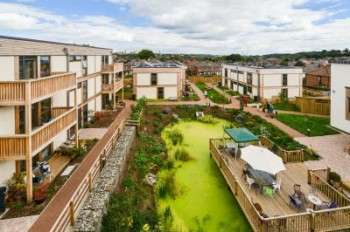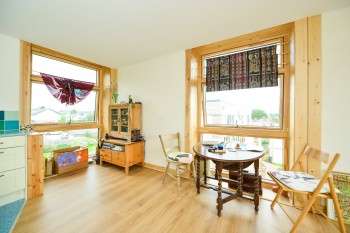Straw cuts energy bills by 90%

While the UK is consumed by arguments about the cost of energy, fuel poverty and market failure, some have managed to sidestep these issues altogether.
Residents of a unique new housing development in Yorkshire are enjoying exceptionally low energy costs having spent six months in their new homes which are made from straw bale panels.
The LILAC (Low Impact Living Affordable Community) homes in Bramley, Leeds, is the UK's first ecological affordable cohousing project, and has been constructed using straw bale technology developed by our researchers here in the Department of Architecture and Civil Engineering, and straw technology company Modcell.
The community consists of 20 homes and is home to 35 adult and 8 child residents, who have just received their first quarterly energy bills.
As a result of the increased insulation provided by straw, the community has managed to reduce its gas bills by 90 per cent compared to the average for Leeds.
Energy saving starts with the basics at LILAC. The homes are designed not to use energy in the first place – they are super insulated, using straw bale external walls and roofs and triple glazed windows. They are also very airtight, so they don't leak heat to the outside through drafts.

The homes cleverly recycle waste heat back into the building through what is called MVHR - Mechanical Ventilation Heat Recovery. Heat from warm stale air leaving the building is extracted and exchanged to cool fresh air drawn in by the system. This not only reduces heating bills even further, but results in better indoor air quality.
Using renewable energy across the community has resulted in even lower fuel bills. There is a 29 kW array of community owned solar panels across the site. The feed-in tariff income from these is placed into a shared account to pay for the communal water, gas and electricity used on site. Solar hot water panels provide most of the hot water requirements for bathing and washing up.
Dr Andy Thomson said: "We are involved with LILAC as part of our current EACi funded research project; EuroCell. The energy performance that the residents have reported for the buildings so far is really pleasing. We're looking to take thermal images of the homes in use this winter to get a clear picture of just how much heat is retained compared to a typical brick and mortar structure in the region."
Paul Chatterton, and his partner Tash Gordon, live in one of the four bedroom houses at LILAC with their young son. Their annual gas bill is likely to be just £30 and their electricity bill £160. A combined energy bill of £190 compares favourably with their previous house, where the annual energy bill was £1500. This is a significant reduction of 87 per cent that will repeat year on year.

Jenny March moved to LILAC in May with her partner, and lives in a two bedroom flat. She said: "The big difference we've noticed is that there is no draught, it is always warm in our flat. We have a lot of space, our rooms are large, but they are costing so little to heat and to keep warm. Our heating is usually on for only a couple of hours a day. Another big benefit of the straw walls is that they insulate noise, so the flat is really quiet. I've lived in other flats where I could hear everything my neighbours said or did, so this is another huge benefit!"
Craig White from Modcell said: "What LILAC shows is that straw bale housing, modern energy generation and storage technologies and a mutually cooperative approach to living can deliver significant economic benefits to a community through cheaper energy bills. It also reduces carbon emissions at a neighbourhood level and eradicates fuel poverty. LILAC is a fantastic place to live and shows that a modern lifestyle can be achieved without costing the earth financially or environmentally."
Dr Thomson added: "These buildings are extremely low impact, as the straw locks in carbon dioxide, and by working with local farmers the panels are assembled local to the site of construction. The Modcell panels are pre-fabricated and straightforward to use, so any construction company could build with them. This means that ModCell will be able to scale up production and that more communities will be able to benefit from the construction of these homes in the future."
More information: To find out more about the LILAC community see www.lilac.coop/ and for more on building with straw see www.bath.ac.uk/research/case-s … -straw-bale-building.
Provided by University of Bath





















